I was determined.
I’d created my Mona Lisa. The Yoga of Max’s Discontent (The Seeker in India) was the one novel I’d wanted to write all my life. I’d finally cracked the spiritual-page-turning adventure blend I’d been struggling with for years. Goodreads advance reader reviews were outstanding. In Random House’s Riverhead imprint, I had one of the best publishers in the US launching the book. On the eve of the book release, I sat back and waited for the media buzz to kick-in.
It didn’t.
The media lavished praise on the usual dysfunctional-families-in-New-York stories. Amazon rankings were dominated by young-adult romances. With a slate of big summer releases, no one cared about a tiny debut novelist. US Publishing is unforgiving for outsiders.
Luckily, I was prepared for this. PR can no longer make or break your book. In the last six months, I’ve experimented with nearly every advertising medium in the US and India and have solid data for what truly works to drive immediate momentum for your book, after which the book takes on its own life. Or not. From my Indian publishing history, I know that after the 1st 5000-10,000 copies, some magic, something beyond your control, has to set in for word-of-mouth to spread. There’s no formula for it. So what works to get your book off the ground?
First off, here are my results.
I’ve sold 10,000 copies of The Yoga of Max’s Discontent in the US in the 1st 2 months of launch with the approach below. This is split as:
Direct Recorded Sales(Amazon, Other Online Retailers, Retailers with Online Replenishment Systems etc.)= ~6100 copies.

In addition, Random House has shipped ~12,000 copies in the first print run to physical retailers, independent book stores etc.
We know online sales account for nearly half of book sales and re-orders for The Yoga of Max’s Discontent are coming in already(yeah!) so a conservative assumption is that a minimum of 30% of these books have sold already=3,500 books.
10,000 books in 2 months is not a blockbuster by any means. Yet, the numbers are significant in an industry where the average book sells a dismal 250 copies/year and 3000 copies in its lifetime.
Even well reviewed novels by major publishers with significant press coverage rarely sell more than 15,000 copies in a year and most struggle to break past the 5,000-7,000 copies mark.
So, 10,000 copies in 8 weeks is by all accounts a strong start for a debut novel.
The one advertising strategy to sell 10,000 copies of your novel in 2 months.
Here is the 3-step summary:
Step 1: Get 100-150 reviews of your book on Amazon on launch day.
Step 2: Reach hyper-targeted segments with Facebook advertising.
Step 3: Create one simple, review/testimonial focused Facebook ad driving to your Amazon page.
That’s it. Ignore all the other distraction around advertising a novel—empty bookstore events, blogger tours, random Tweets, manic Facebook updates–none of that will move the needle. Just the three steps above will get your book off to a solid start. Now, let’s double-click on each of these.
Step 1: Get 100-150 reviews of your book on Amazon on launch day.
This is the single most time-consuming activity in your plan and also the most important. You’ll be driving advertising to your Amazon page and no matter how compelling the book description or how powerful the media reviews, the #1 driver of page conversion will be the quality and quantity of real, unbiased consumer reviews.
On average in my work with Amazon in my corporate life, I’ve seen a +2pp improvement in conversion rates with every 100 reviews on the page. Said another way, in the last brand I handled, for every 100 visits to the page, organic or driven through advertising, we saw these conversion rates:
-100 reviews=3% conversion=3 product sales
-200 reviews=5% conversion=5 product sales
….and so on, upto a point of diminishing returns of course.
Currently, The Yoga of Max’s Discontent has 220 reviews on Amazon (all 100% unbiased and real) and co-relating book sales with Facebook advertising stats, I’m seeing similar conversion rates on the page.
This is very important so I’ll emphasize again: Don’t start book advertising until you have at-least 100 reviews on your page else your conversion rates will be dismal and the ROI on spend will be terrible.
I’ll write a separate post on how to get 100 reviews for your book on Day 1 since it requires a lot of systematic outreach. To give you a flavor, here are the stats:
For every 100 people you cold outreach to review your book, 50 will write back.
For every 50 who write back, 25 will actually read your book.
For every 25 who read the book, 12 will finish it.
For every 12 people who finish the book, 6 will actually review it.
For every 6 people who review the book, 4 will remember to post the review on Amazon on launch week.
Net there’s a 50% drop off at each stage (except the last), which means you need to reach out to 2500 people in order to get 100 reviews. How do you find 2500-3500 relevant people to request to review your novel in the pre-launch phase? Remind me to write a blog about it!
Step 2: Reach hyper-targeted segments with Facebook advertising.
Here are all the mediums I experimented with for paid book advertising, spending a little against each, and evaluating them quickly (note, I’m a CMO in my other life so I know a little of what I was doing :-)):
1. Facebook Advertising= Strong.
2. Amazon Advertising=Medium.
3. You-Tube Advertising=Weak.
4. Instagram Advertising/Influencer Outreach=Weak.
5. Goodreads Advertising=Disaster.
6. Twitter Advertising=Disaster.
7. All the others—email list, boosted posts on social etc.—are decent but severely limited by scale. Example, Email Lists typically show a conversion rate between 1-5% so even if you have a list of 10,000 folks, you’ll sell a maximum of 500 copies. Good but not enough scale to make a dent.
Net, Facebook advertising is the best ROI on your spend if you know how to do it right so let’s focus on that for this post.
The one key to effective Facebook targeting.
Beyond the usual demographic targeting (eg, US/India, 25-55 etc.), the one key to effective Facebook targeting is to use the AND functionality to target the exact audience interested in your book.
You need to target people who’re interested in:
– Books/Authors similar to you.
AND
-Interests that correspond to your book.
For example, The Yoga of Max’s Discontent’s bullseye target would be someone who’s read Shantaram, an adventure novel set in India, AND practices yoga.
Incredibly, Facebook allows me to target exactly that person with my book ad. That’s why my targeting below has worked incredibly well to reach the right audiences.
People Interested in pages of Books/Authors Similar to mine
Here’s a snapshot among the 30-40 similar books/authors I chose:
People interested in interest segments that correspond to my book
Here’s a snapshot of the 15-20 interest segments I chose:
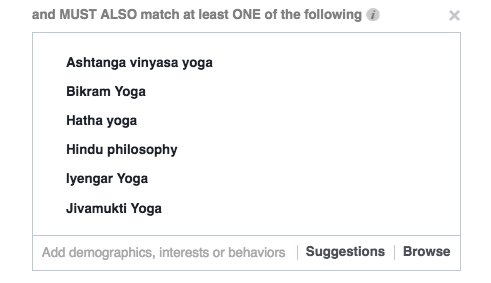
Step 3: Create one simple, proof-focused Facebook Ad creative driving to your Amazon page.
Drumroll please. You’re about to get the one secret of book advertising that works. You’ll have a blockbuster ad if it has these 3 components:
1. Benefit/Claim
2. Proof
3. Call-to-Action.
That’s it. Everything else is redundant. Let’s de-construct my top-performing ad below with thousands of likes, shares, and comments using this principle:
- Benefit/Claim= The two best benefits a book can give are: a)The book will entertain you like nothing else b) The deeper meaning in the book will change your life. One glance at The Yoga of Max’s Discontent’s book reviews and you can immediately see that hundreds of reviewers are saying that the book has changed their life forever. I went singularly after that claim.
- Proof: Credibility is the single most important aspect of any advertising and that’ll come from what people say about your book, not your opinion of it. I have several proof points in this short advertisement: Amazon Top reviewer, 100+ 5 star reviews, #1 Indian bestseller etc, immediately giving credibility to my claim.
- Call-to-Action: Online advertising is at its most power when there’s urgency to click, stopping you from scrolling down the newsfeed. Amazon’s “35% discount today” is the best I could do since the publisher and Amazon set the pricing for a traditionally published book.
Now, let’s look at ads which didn’t work in my testing. They focus on the book’s story versus the benefit to the reader. I use the same proof point but the proof is buried in the thick text. Nothing here stops you from scrolling down the newsfeed:
I tried the same ad with different images as well as a book video trailer. Still didn’t work as measured by significantly higher Cost-per-click and lower relevance scores than my control ad.
Net, the first ad does the best job of communicating claim+proof+call-to-action in the simplest possible way, hence it works incredibly well.
Sales are great but how much does it cost?
Let’s start with my book advertising philosophy first
For each of my novels, my goal has been to lose money or at best, breakeven on my 1st 10,000 copies. I’ve believed deeply in each of my books and my hypothesis is that once the 1st 5-10,000 copies sell, there’ll be enough critical mass for word-of-mouth to kick in and the books will sell by their own accord after.
So far, this strategy has worked. My writing income has exceeded my book marketing expenses by a factor of 5-10x for every book. Please read this for a full breakdown of my writing income over the last decade. Quite like a start-up, my book income flows in after the initial investments through word-of-mouth leading to future book sales royalties, movie deals etc.
In practice, for The Yoga of Max’s Discontent in US
I’ve spent $20K on The Yoga of Max’s Discontent advertising, in total, including my testing. On a unit basis, $20K for 10K copies=$2/copy, which is a fraction higher than my royalty=$1.80 or so/copy, so I’ve lost money on advertising. On the other hand, I’ve spent only a fraction of my advance (read this for a full summary of my advances) so I’m still positive–which is a first for me at this early stage.
The more encouraging news here is that I stopped advertising two weeks ago and the book sales are at the same level as during advertising, further confirming my hypothesis that post the initial push, word-of-mouth drives a book sales(if the book is good of course!).
If you’re in India
Indian Facebook advertising costs are roughly 1/4th the cost of the US and conversion rates are similar. Here’s the latest comparison of Facebook Cost-Per-Click on The Yoga of Max’s Discontent vs. The Seeker for the exact same ad.
The Yoga of Max’s Discontent(US)= $0.40 CPC.
The Seeker(India)=$0.10 CPC
So the equivalent advertising costs to sell 10,000 copies would be $5,000. On the other hand, your royalty is proportionately lower as well so you’ll probably end up losing money on your 1st 10,000 copies in India as well.
On the upside you’ll save money on all the random activities authors burn their money on but don’t move the needle: PR agencies, book tours, flashy newspaper ads etc.
If you’re self-published
The economics will be far better of-course since your royalty is 100% vs. the 10% that you get from a major publisher. Having said that, I know without my editors at Random House, Chiki Sarkar(read my interview with Chiki here) and Jake Morrissey(read my interview with Jake here), my book would be far inferior and won’t have the overwhelmingly positive reviews that are the #1 driver of conversion.
One Final Tip
Although Facebook advertising is very intuitive, I highly, highly recommend hiring a freelance professional to manage it for you. You should know the brass-tacks as above but small optimizations done by a professional can dramatically reduce your costs and improve your book sales. I worked with Ayush Pant from Aurelius and recommend him.
Please leave me a note in the comments to let me know if I can clarify anything. And here’s to your 1st 10,000 copies!


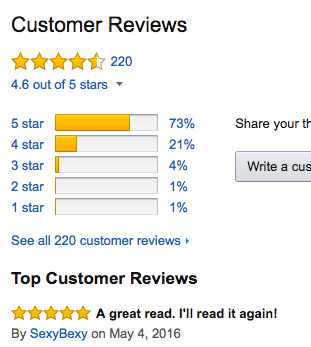
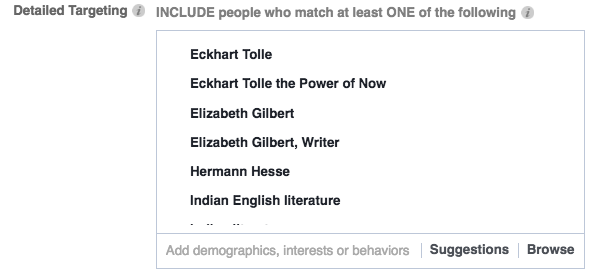
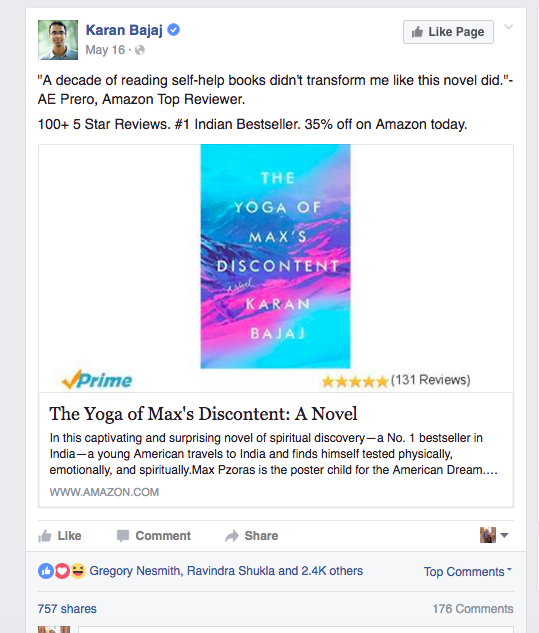
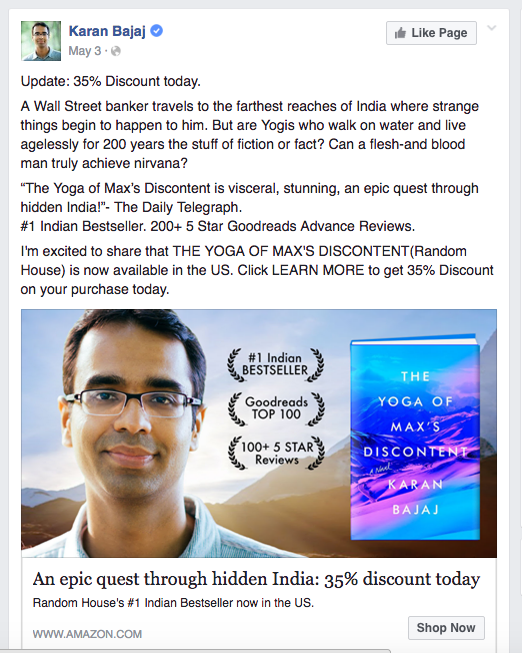
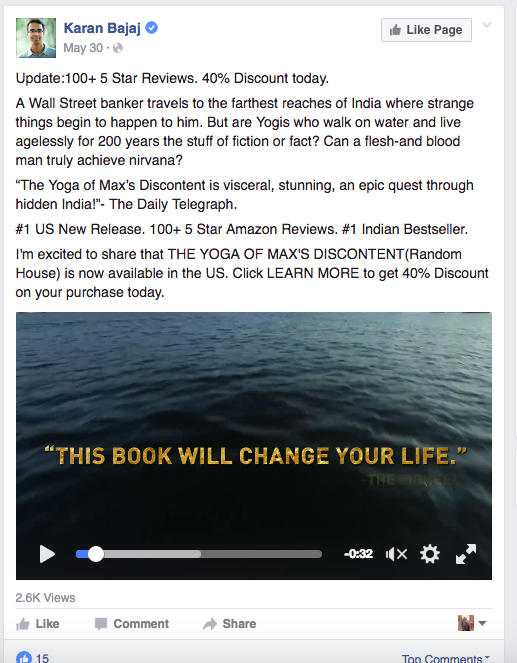
















29 Comments